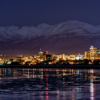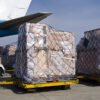How the Declining Wild Salmon Population is Affecting Commercial Fishing
Alaska’s salmon population has been declining in recent years and this decline has presented a unique set of challenges to the state of Alaska. The Chinook salmon has seen the greatest decline in recent years and at one point, salmon runs in the Yukon, Kuskokwim and Kenai Rivers had declined to the point where several major fisheries were either strictly limited or closed altogether. The villages along these rivers are especially dependent on the Chinook salmon for both commercial harvests as well as for supplying sustenance for families.
When the salmon population is negatively impacted by certain factors, the economic impact is felt throughout the state. Commercial fishing boats see a lower seasonal yield which obviously impacts fisheries. Not only do fisheries feel the impact of the decline, but consumers do as well.
Commercial fishing is Alaska’s number one industry and the salmon caught in Alaska is shipped world-wide. When the demand for salmon stays constant but supply is lower than normal, this drives up the cost to consumers. While this situation can be frustrating for all, it is important to understand the factors that are leading to the decline in the salmon population so that, over time, the situation can be reversed.
Factors Affecting Wild Salmon Populations
Temperature
Researchers are uncertain why these salmon populations are declining, however some believe the fact that Alaska’s temperatures are warming is a contributing factor. During the various stages of a salmon’s life, it’s important that the temperature of their habitat (the water) be at very specific levels otherwise the salmon can become vulnerable to disease and in some cases, the temperature can become so warm that it becomes lethal for the salmon. Temperature changes of just a few degrees can have a significant impact on the life cycle of salmon.
By-catch and Ocean Trawlers
These ships drag huge nets in their wake in order to catch Pollock and other deep water fish but their nets also scoop up other sea life, including salmon. When salmon gets caught up in these nets they are then unable to migrate back to their streams for spawning which of course impacts the next generation of salmon populations. While these boats are a vital part of the commercial fishing industry, their trawling inadvertently has a negative impact on the salmon population.
Dams and Mining
While there are efforts underway to restore salmon streams that have been disrupted in some parts of the state, there are other projects underway that will continue to have an impact on salmon populations. There are dozens of active and developing mines along Alaskan rivers and their headwaters in Canada but there are also other industrial projects that could have a significant impact on some salmon runs. The Susitna River is home to all five species of salmon- pink, chum, Coho, sockeye and the 4th largest Chinook run in Alaska and has also been tapped as a site for an 885 foot dam that would support the energy needs of Anchorage and surrounding communities. Salmon spawning downstream from this proposed dam, would be adversely affected by the changes in stream flow that the dam would produce.
While projects such as these as well as other industries are also vital to the well-being of Alaska, it is important that each understand their impact on the other and work together in order to minimize the damage to this extremely vital and fragile ecosystem.
Potential Solutions for Increasing Populations
While there is no definitive solution to restore the Chinook salmon population, many believe the best way to preserve the species is to bring restoration to their habitat. Salmon are an incredibly sustainable and renewable resource and by working diligently to restore their natural habitat, researchers are confident that the populations will be restored as well.
Here at Alaska Air Forwarding, we’ve been serving Alaska’s fishing industry since our beginning in 1965, and we have seen first-hand, how vital this industry is to Alaska’s economy. We are committed to doing what we can to support the efforts to protect and restore the habitat of Alaska’s fishing industry.






